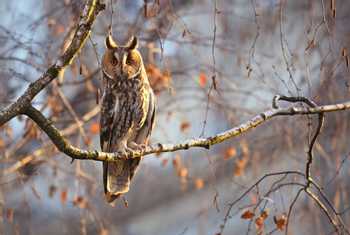


Tour Itinerary and Reports
Can I help you?
Hungary's Winter Birding Bonanza
Tour Code: HUN07A 6-day birdwatching holiday to Hungary, incorporating Hortobágy and Bükk National Parks, in search of the country's finest avian late-winter highlights, including a roost of Long-eared Owls!
£1,795
£1,595
Highlights
Tour Itinerary and Reports
Can I help you?
Quick Enquiry
Summary
This 6-day holiday sets out to enjoy some of the very best birdlife during Hungary’s late-winter season. Starting off from Budapest airport, it is a relatively short drive to see one of Europe’s most spectacular gatherings of Long-eared Owls, with over 500 individuals found in a single village in the winter of 2023! We then visit the famous Hortobágy National Park. In winter, the sheer abundance of wildfowl and great flocks of other bird species which attract birdwatchers from all over Europe will be the main focus. Staying close to the heart of the park, we will seek two rarer species of geese – Lesser White-fronted and Red-breasted – which join the huge flocks of Greylag and Greater White-fronted Geese. Great Bustards roam the fields here, while the area is magnificent for birds of prey, most notably Eastern Imperial Eagle, Hen Harrier, Rough-legged Buzzard and Saker. Following on from the Hortobágy, we venture north to Bükk National Park to visit vast, ancient forests which are home to six species of woodpecker, all of which should be in full voice and display as they mark out their territories. Although spring migrants are yet to arrive, these will be replaced by some of the scarcer residents here, including Ural and Eurasian Pygmy Owls and we will even search for Wallcreeper at nearby quarries.
- View a large roost of Long-eared Owls
- Visit Hortobágy National Park
- Red-breasted and Lesser White-fronted Geese likely
- Walk ancient forests for a variety of woodpeckers
- Possible chance of Wallcreeper
- Comfortable accommodation throughout
- Led by local expert naturalists
Once the coldest days of winter have passed, Hungary's frozen landscapes slowly come back to life. Freshwater lakes and wetlands thaw, encouraging thousands of ducks, geese and other wintering birds to gather to feed, roost and bathe, bringing with them some of the region's scarcer visitors such as the beautiful Red-breasted Goose and the striking Smew. At the same time, the vast forests in the north of the country also start to show the first signs of spring, with birdsong gradually increasing through February and March and woodpecker display activity reaching its peak.
This 6-day holiday focuses on the very best of Hungary's late-winter birdlife. We begin with a flight to Budapest, the nation's attractive capital, from where we transfer east to the Hortobágy National Park for a 3-night stay. Enroute, we will stop at a small village to visit a roost of Long-eared Owls. A remarkable 500 birds roosted here in the winter of 2023!
We will then complete our drive to the Hortobágy National Park and check into our ideally-positioned hotel, which is located in the heart of the national park close to the reserve's key wildlife hotspots. The wetlands of the Hortobágy attract huge numbers of wildfowl during the winter months, along with a wonderful variety and abundance of raptors, finches, buntings and other species seeking relief from the harsh weather further north. Huge flocks of Greylag and Greater White-fronted Geese roost on the extensive network of fishponds and other lakes that dot the national park and then venture out into the nearby fields during the day to graze. They are joined by small numbers of two rarer species, the delicate Lesser White-fronted Goose and Red-breasted Goose, arguably the most beautiful of the family. Large flocks of Wigeon, Teal, Shoveler, Pintail and other ducks winter here too — along with the attractive Smew — and it is likely that we will see (and hear) the first returning Common Cranes of the year, stopping over to rest and feed on their long journey north. Other birds to look out for include Pygmy Cormorant, Spoonbill, Bearded Tit, Crested Lark and Great Grey Shrike. The grassy plains and steppe of the Hortobágy (the so-called 'puszta') are also justly famed for the number and diversity of raptors that winter here, most notably White-tailed Eagle, Hen Harrier, Rough-legged Buzzard, Long-legged Buzzard, Saker and Eastern Imperial Eagle. We will also ensure we track down a flock or two of Great Bustard, the reserve's most well-known avian inhabitant!
Leaving the plains behind, we next venture north to Bükk National Park for our final two nights of the holiday, crossing the impressive Tisza River en route. The extensive old forests of the Bükk Hills are home to six species of resident woodpecker (plus Wryneck in the summer), all of which should be vocal and active in early March as they stake out their territories for another year. A walk among the trees here — with the late-winter sunlight filtering through the branches — could produce Black, Grey-headed, White-backed, Lesser Spotted, Middle Spotted and Syrian Woodpeckers and, because the trees are still leafless at the time of our visit, we will have great opportunities for prolonged views as they 'drum' and call. This is also a good time to go in search of some of the region's scarcer residents, including Ural Owl and Pygmy Owl, both of which breed early. We hope that a night walk or two may prove successful. The Bükk Hills are also home to the striking Hawfinch and wintering flocks of Brambling, plus Marsh and Willow Tits too. Meanwhile, a glance down to the woodland floor may reveal a non-avian highlight such as a Fire Salamander which often frequents the damp forest tracks.
During our time in the Bükk Hills we will search nearby stone quarries for the resplendent Wallcreeper. Small numbers usually winter in these quarries and we will make a special effort to find this sought-after and striking bird if our guide is aware of any wintering nearby. Other rocky scree specialists, such as Rock Bunting and Alpine Accentor, can also be found in these quarries from time to time. Wolves reside in the area too and, although we would need a great deal of luck to see one of these secretive canines, hearing them howl from a distance is a realistic possibility!
Our time exploring the plains and hills of Hungary concludes with a short drive back to Budapest Airport from where we catch our flight home.
Outline Itinerary

What's Included?
- Flights
- Accommodation:
A mix of comfortable hotels, all rooms having private facilities.
- Food:
All food when in Hungary is included
Dates & Prices
2026

Tour Leader: Mike Crewe
Born and raised in Oxford, Mike has lived most of his life in East Anglia, with a short stint in West Sussex and a spell in the USA. He has been a birdwatcher ‘since birth’ (so he says!) and initially took up a career in horticulture, which kick-started an interest in plants. Over time, Mike has evolved into an all-round naturalist with interests in all branches of natural history, working a short time for the British Trust for Ornithology and as an environmental consultant before taking up wildlife tour guiding in 1996. Indeed, he first led walks for local wildlife trusts and bird groups as long ago as 1982 and has continued as a professional guide since the late 1990s, except for six years in the USA, where he worked as Program Director for the famous Cape May Bird Observatory in New Jersey.
Now settled back on the Norfolk coast, he lives with his wife, who is also a professional birdwatching guide. He has served as a committee member on the Suffolk Birds Records Committee, edited various natural history newsletters and bird reports and recently authored two identification guides on the flora of Breckland. Most recently, he has taken on a role as Assistant Editor for British Birds magazine and serves as the Norfolk tutor for the national ‘Identiplant’ training scheme. Somehow, he also manages to find time to maintain two identification websites on the flora of East Anglia and the wildlife of Cape May County, New Jersey!
2027
Prefer to Travel in a Private Group?
For any interested natural history club or society, we can arrange for a private departure of this tour.
Enquire
Tour Reports
Why Naturetrek?
At Naturetrek we craft expertly-guided group and tailor-made wildlife holidays and cruises to all seven continents. On one of our holidays, you can be assured that our passionate team will enable you to experience and enjoy the best of the world's wildlife and natural spectacles in as comfortable and rewarding a manner as possible, caring as best we can for the environment in the process. We are proud to provide:
- The widest choice of wildlife holidays worldwide
- Tours managed and led by naturalists, for naturalists
- Outstanding value and exceptional customer service
Furthermore, as a Naturetrek client, our office team are always to on hand to help you – so if you have any queries about your holiday, whether before or after you have booked, we will be delighted to answer them on the phone. Please just give our team a call!



 Loading search...
Loading search...

















